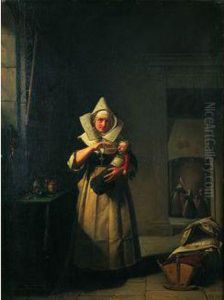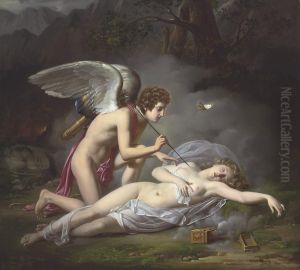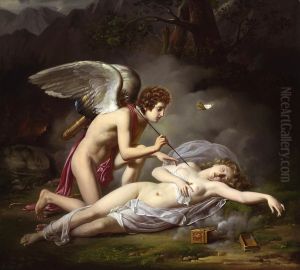Michel Philibert Genod Paintings
Michel Philibert Genod was a French artist born in 1795. Despite not being widely known in the mainstream art world, his contributions to art, particularly in religious painting and teaching, mark significant aspects of the 19th-century French art scene. His life and work offer a glimpse into the period's artistic movements and the broader cultural shifts in France during his lifetime. Genod's artistic journey was deeply influenced by the political and social upheavals of his time, including the aftermath of the French Revolution and the Napoleonic Wars, which shaped the cultural landscape of France and Europe.
Genod's work primarily focused on religious themes, reflecting the 19th century's revival of religious art in France, partly as a reaction against the earlier revolutionary period's secularism. This was a time when the church sought to reaffirm its influence in society, and artists like Genod played a crucial role in this visual renaissance. His paintings, characterized by their spiritual depth and technical proficiency, were appreciated for their ability to convey profound religious sentiment, a testament to his skill and dedication to his craft. Notably, his works contributed to the visual culture of the period, serving both devotional purposes and the aesthetic appreciation of religious art.
Apart from his artistic contributions, Genod was also involved in the education of aspiring artists, passing on his techniques and knowledge to a new generation. This aspect of his career underscores the importance of mentorship and teaching in the arts, ensuring the continuity and evolution of artistic traditions. His role as an educator also reflects the broader educational reforms in France during the 19th century, which began to place a greater emphasis on arts education.
Despite the limited recognition of Michel Philibert Genod's work in contemporary art historical discourse, his contributions to religious painting and education remain significant. His legacy is a reminder of the diverse and rich tapestry of artists who have shaped the course of art history, often beyond the limelight of fame. Genod's life and work exemplify the dedication to art and the spiritual quest that defines much of religious painting, offering insight into the complex interplay between art, religion, and society in 19th-century France. He passed away in 1862, leaving behind a body of work that, while not widely celebrated, is a testament to his artistic spirit and the era he lived in.




